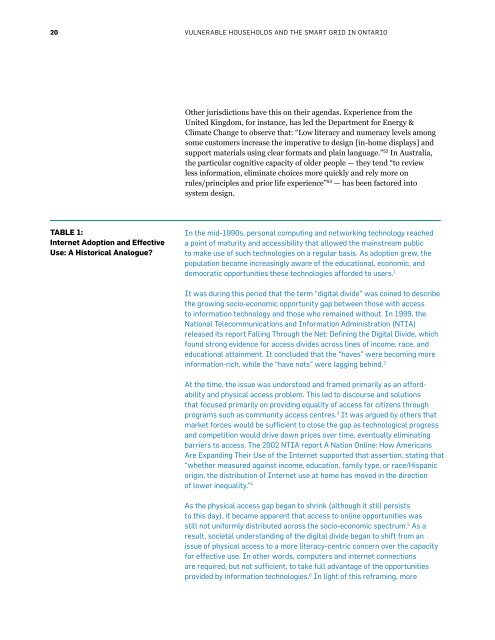Vulnerable Households and the Smart Grid in Ontario
Create successful ePaper yourself
Turn your PDF publications into a flip-book with our unique Google optimized e-Paper software.
20<br />
VULNERABLE HOUSEHOLDS AND THE SMART GRID IN ONTARIO<br />
O<strong>the</strong>r jurisdictions have this on <strong>the</strong>ir agendas. Experience from <strong>the</strong><br />
United K<strong>in</strong>gdom, for <strong>in</strong>stance, has led <strong>the</strong> Department for Energy &<br />
Climate Change to observe that: “Low literacy <strong>and</strong> numeracy levels among<br />
some customers <strong>in</strong>crease <strong>the</strong> imperative to design [<strong>in</strong>-home displays] <strong>and</strong><br />
support materials us<strong>in</strong>g clear formats <strong>and</strong> pla<strong>in</strong> language.” 52 In Australia,<br />
<strong>the</strong> particular cognitive capacity of older people — <strong>the</strong>y tend “to review<br />
less <strong>in</strong>formation, elim<strong>in</strong>ate choices more quickly <strong>and</strong> rely more on<br />
rules/pr<strong>in</strong>ciples <strong>and</strong> prior life experience” 53 — has been factored <strong>in</strong>to<br />
system design.<br />
TABLE 1:<br />
Internet Adoption <strong>and</strong> Effective<br />
Use: A Historical Analogue?<br />
In <strong>the</strong> mid-1990s, personal com put<strong>in</strong>g <strong>and</strong> network<strong>in</strong>g technology reached<br />
a po<strong>in</strong>t of maturity <strong>and</strong> accessibility that allowed <strong>the</strong> ma<strong>in</strong>stream public<br />
to make use of such technologies on a regular basis. As adoption grew, <strong>the</strong><br />
population became <strong>in</strong>creas<strong>in</strong>gly aware of <strong>the</strong> educational, economic, <strong>and</strong><br />
democratic opportunities <strong>the</strong>se technologies afforded to users. 1<br />
It was dur<strong>in</strong>g this period that <strong>the</strong> term “digital divide” was co<strong>in</strong>ed to describe<br />
<strong>the</strong> grow<strong>in</strong>g socio-economic opportunity gap between those with access<br />
to <strong>in</strong>formation technology <strong>and</strong> those who rema<strong>in</strong>ed without. In 1999, <strong>the</strong><br />
National Telecommunications <strong>and</strong> Information Adm<strong>in</strong>istration (NTIA)<br />
released its report Fall<strong>in</strong>g Through <strong>the</strong> Net: Def<strong>in</strong><strong>in</strong>g <strong>the</strong> Digital Divide, which<br />
found strong evidence for access divides across l<strong>in</strong>es of <strong>in</strong>come, race, <strong>and</strong><br />
educational atta<strong>in</strong>ment. It concluded that <strong>the</strong> “haves” were becom<strong>in</strong>g more<br />
<strong>in</strong>formation-rich, while <strong>the</strong> “have nots” were lagg<strong>in</strong>g beh<strong>in</strong>d. 2<br />
At <strong>the</strong> time, <strong>the</strong> issue was understood <strong>and</strong> framed primarily as an affordability<br />
<strong>and</strong> physical access problem. This led to discourse <strong>and</strong> solutions<br />
that focused primarily on provid<strong>in</strong>g equality of access for citizens through<br />
programs such as community access centres. 3 It was argued by o<strong>the</strong>rs that<br />
market forces would be sufficient to close <strong>the</strong> gap as technological progress<br />
<strong>and</strong> competition would drive down prices over time, eventually elim<strong>in</strong>at<strong>in</strong>g<br />
barriers to access. The 2002 NTIA report A Nation Onl<strong>in</strong>e: How Americans<br />
Are Exp<strong>and</strong><strong>in</strong>g Their Use of <strong>the</strong> Internet supported that assertion, stat<strong>in</strong>g that<br />
“whe<strong>the</strong>r measured aga<strong>in</strong>st <strong>in</strong>come, education, family type, or race/Hispanic<br />
orig<strong>in</strong>, <strong>the</strong> distribution of Internet use at home has moved <strong>in</strong> <strong>the</strong> direction<br />
of lower <strong>in</strong>equality.” 4<br />
As <strong>the</strong> physical access gap began to shr<strong>in</strong>k (although it still persists<br />
to this day), it became apparent that access to onl<strong>in</strong>e opportunities was<br />
still not uniformly distributed across <strong>the</strong> socio-economic spectrum. 5 As a<br />
result, societal underst<strong>and</strong><strong>in</strong>g of <strong>the</strong> digital divide began to shift from an<br />
issue of physical access to a more literacy-centric concern over <strong>the</strong> capacity<br />
for effective use. In o<strong>the</strong>r words, computers <strong>and</strong> <strong>in</strong>ternet connections<br />
are required, but not sufficient, to take full advantage of <strong>the</strong> opportunities<br />
provided by <strong>in</strong>formation technologies. 6 In light of this refram<strong>in</strong>g, more

















